Planeswalker's Guide to Bloomburrow, Part 3
We conclude our exploration of the plane of Bloomburrow with part three of the Planeswalker's Guide! Be sure to check out part one and part two for even more details about the plane and it's animalfolk residents.
Batfolk 

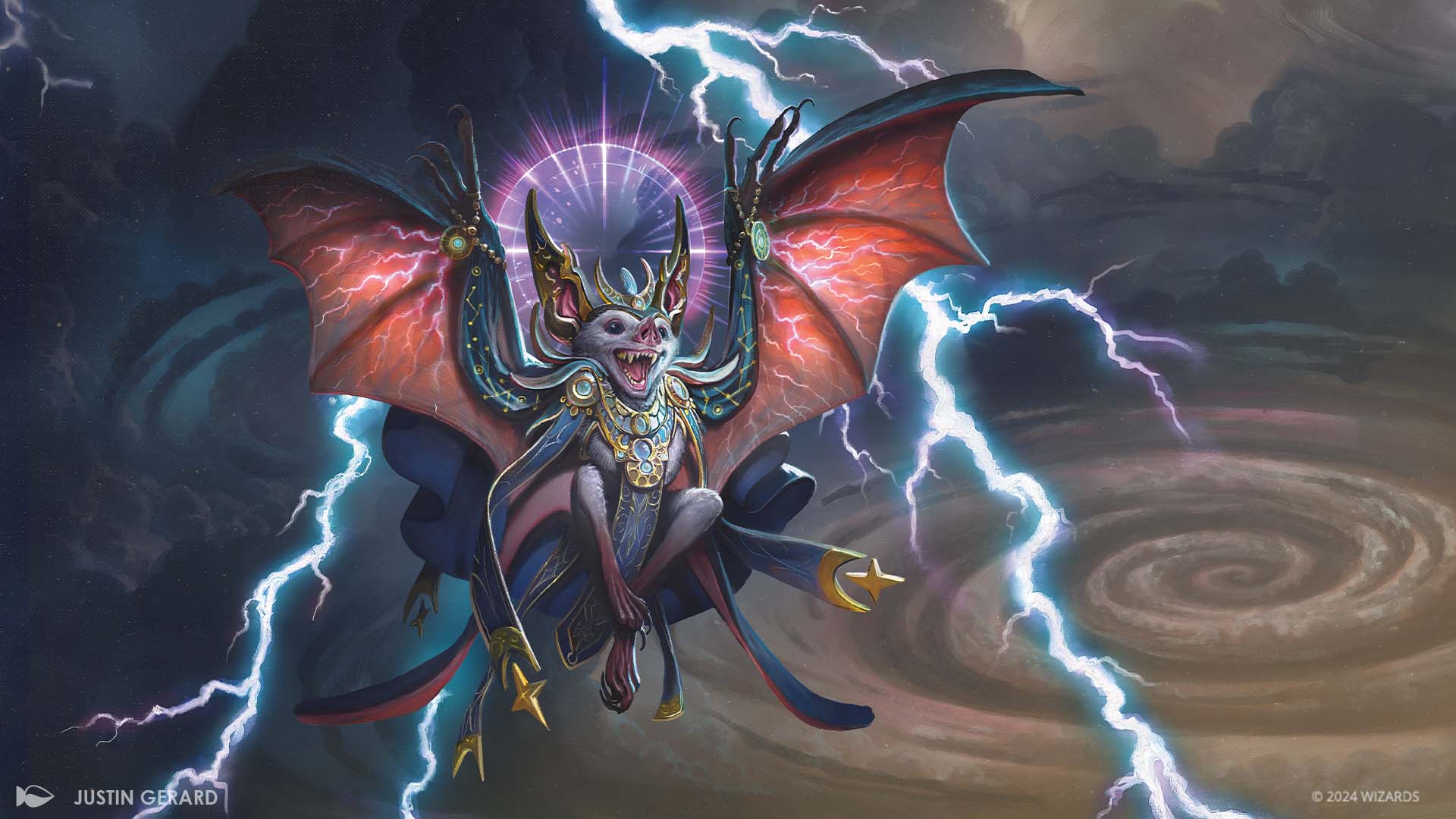
Batfolk are eccentric and mysterious nocturnal defenders. Superstitious, kind, and ferociously protective, batfolk have a strong sense of loyalty, tradition, and order. Batfolk communities are defined by rigid roles, as they look to the predictable certainty of the moon and stars, using the patterns of the night sky to direct their choices and fuel their magics. At their best, batfolk are dependable and loyal protectors with strong ties to their compatriots. At their worst, batfolk are obtuse, adhering overly rigidly to hierarchies and order.
Personalities
Batfolk community consists of rigid roles and clearly defined hierarchies. Leaders of the larger community are a mixture of magic practitioners, spiritual leaders, and martial veterans. Individual batfolk are frequently solitary; they can be found flying out alone on patrols or engaging in quiet study. Being nocturnal, they interact less frequently with the other denizens of Valley and are often viewed as aloof and enigmatic. Some batfolk consider themselves as destined protectors of Valley, internalizing their role as guardians of the delicate balance of safety within the larger animalfolk community.
Batfolk are concerned with large-scale questions of balance, thinking on a cosmic scale. Fortune-telling and star reading are popular batfolk hobbies, as they lead their lives in accordance with the ideals they see arranged in the stars. This often perpetuates their detached eccentricity, as they struggle to hold mundane conversations and relate to others. Even within batfolk communities, there are still some who are more on the eccentric side, those inclined toward adventure or those that cast off their predetermined path. These batfolk are called Drifting Stars and are regarded with a mixture of fascination and frustration by the community at large.
Night Keepers
Batfolk are the protectors of Valley during the evening hours when other animals are asleep. One of the core beliefs of batfolk is the understanding that in all things there is balance. There cannot be night without day, light without shadow, or life without death. Because batfolk often take on the responsibility of nocturnal safety and watch alone, they request lifeforce from the animalfolk of the day to fuel their protection. Their methods for gathering this energy can be heavy-handed, but their services and dedication cannot be doubted.
The Lunar Paean
At the end of each of the four moon phases (new, waxing, full, waning), batfolk across Valley host a celebration known as a Lunar Paean. Batfolk use the Lunar Paean to share their beliefs and communicate a respect for the cycle of life and death, light and dark. Led by the most venerated and powerful of the community, the Lunar Paean is one part party and two parts auspicious ritual. The batfolk are frequently joined by other denizens of Valley who were born during the same lunar pattern as when the ritual is held. Fortunes are performed for those present, and children born during the current phase are assigned star charts, while their parents are given guidance to help raise them. The celebration concludes with a moon-watching ceremony where families can look out into the firmament and assign stars to recently deceased loved ones or find the stars of their ancestors.
Their Role in Valley
Batfolk are the nocturnal protectors of Valley as well as organizers of celebrations and rituals throughout Valley. One of their primary roles is the establishment of large-scale projects with their communal organization and resources. Aside from organizers, batfolk can be found as clerics and musicians, often taking the night shift.
An air of mystique surrounds the batfolk. Outlandish rumors and stories about them regularly float around Valley. Youngsters of other species have been known to tell outrages stories that are quickly shut down by community elders.
It’s uncommon for batfolk to join in adventuring groups, but their desire to protect the denizens of Valley can motivate them to participate in dangerous missions. When they do join, batfolk have no qualms stepping into whatever role a party might need, from armored warriors to warlocks whose magic can shape the flow of battle.
Relationships
With their rigid social structures and adherence to order, batfolk often get in arguments with the more carefree and spontaneous otterfolk. They get along well with the birdfolk, as fellow aerialists who share a similar bird’s-eye view of Valley and a fondness for structure and process
Weaving
Batfolk magic is related to the stars and night sky that they worship, leading to magic that shakes the world when they cast it by channeling the power of the cosmos and beyond. Batfolk also sing as part of casting, which can cause auditory damage as they chant. Batfolk sometimes dabble in minor augury, though their concerns as seers are too far in the future for it to matter to many animalfolk.
Batfolk Structures and Settlements
Batfolk homes are elaborate and intricate structures that hang from and are built into trees, smooth swooping shapes decorated with hanging star lights and intricate spires. They draw upon the firmament for inspiration, with grand sweeping architecture that resembles the phases of the moon and interiors decorated with astrolabes.
Otterfolk 

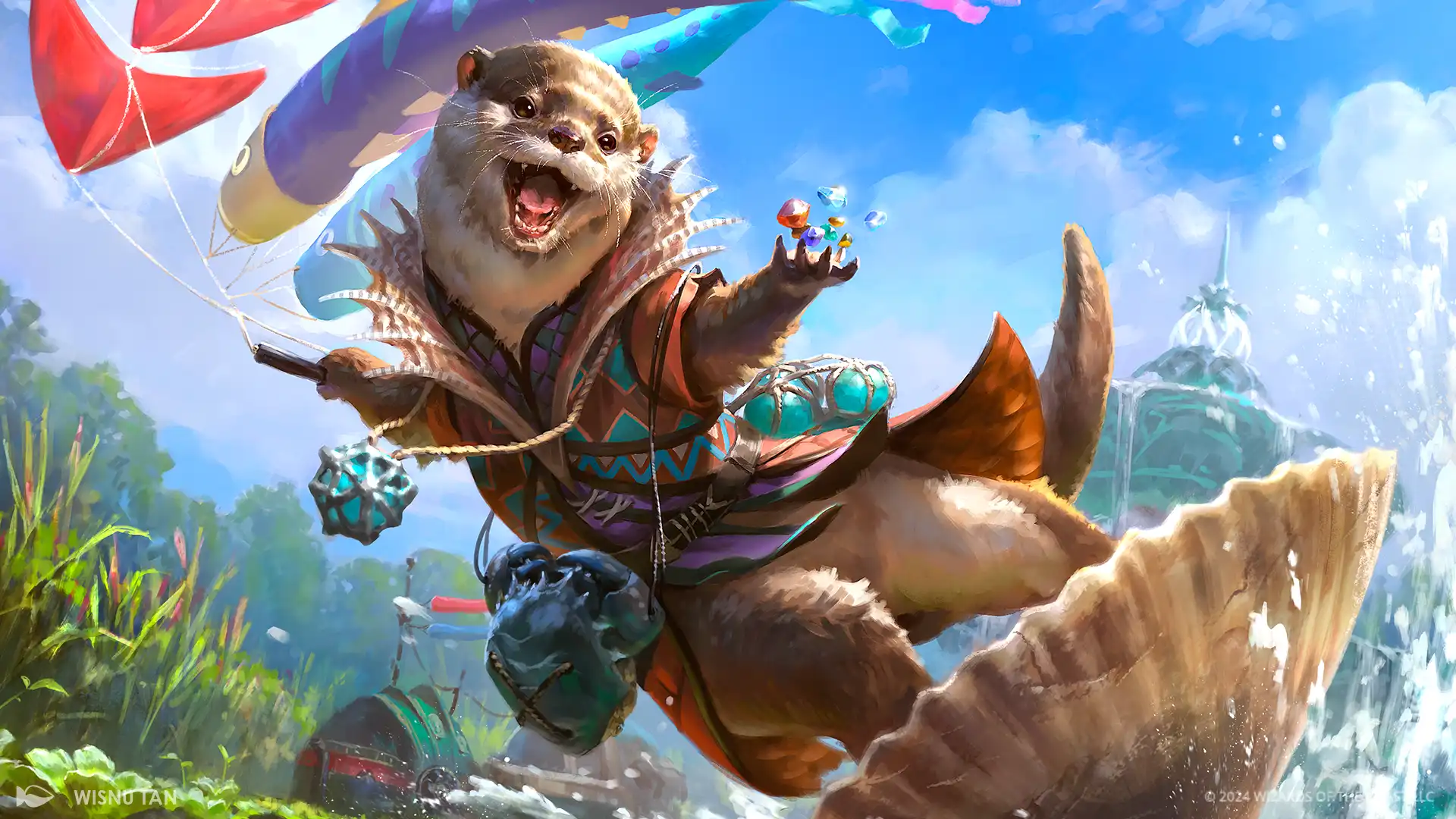
Otterfolk are playful, adrenaline-seeking gamesters and storm chasers. Inveterate water dwellers, otterfolk are gregarious and sociable, with a taste for excitement that can drive them to reckless, daredevil antics that other animalfolk see as thoughtless and unnecessary. At their best, otterfolk are daring, jovial, and adventurous. At their worst, otterfolk are careless, frivolous, and prone to putting others in harm’s way.
Personalities
Otterfolk are playful, clever, and curious—everything’s a game to them. On an extreme, they’re storm-chasers who deliberately hunt down and provoke Calamity Beasts to gather their lightning. Prone to a "live in the moment" approach, they often do not consider the long-term consequences of their actions. Otterfolk don’t really hold grudges. If you’ve made reparations, they’ll put the large wrongs you’ve done against them out of their mind and be your best friend again. Conversely, they will hold small, petty grudges until the end of time.
Otterfolk prefer to spend as much time on the water as possible. They build playful houseboats that they ride up and down the rivers and into the ponds. An otterfolk can easily go it's whole life without ever setting foot on solid ground. Otterfolk don’t hold territory, but consider themselves the veterans and knowledge experts of the rivers. One of their games is quizzing each other on the behavior of the river or challenging each other to races and games that take advantage of currents or terrain.
Otterball
The most popular otterfolk game and their cultural pastime is called otterball, an endless, ongoing game whose exact rules are unknown and whose parameters are constantly shifting. It’s completely baffling to non-otters. The only things anyone else can be sure of are that it’s played largely in water and that the Calamity Beasts are involved in some way—but particulars of scorekeeping, penalties, and illegal moves are a mystery.
Storm Chasers
From a young age, otterfolk engage in storm chasing for sport. This involves following Calamity Beasts as near as possible until the danger feels too great. Great otterfolk storm chasers have plucked the hairs from storm-bearing Beasts, and almost all otters have at least chased flaming wolverine Beasts to capture embers. Otterfolk capture Calamity Beasts’ elemental magic in shells, pearls, and glass bulbs. This process is called Clamming. They have a particular fondness for lightning collected from Calamity Beasts—it seems to have a special significance for otterball. They’re very adept with water, able to twist and bend water to distract, obfuscate, or otherwise befuddle others.
Their Role in Valley
When out on adventures, otterfolk are spellcasting extraordinaries. Danger-seekers by nature, otterfolk are often the first to encounter a Calamity Beast and the last to seek help from others when diverting it.
As the best fishers and divers in Valley, otterfolk often help other species retrieve things that were washed away to the bottom of ponds. Their knowledge of Valley’s rivers also means they’re frequently sought out navigators. Otterfolk often provide transportation to other animalfolk, as river travel is one of the fastest modes of transportation for those who cannot fly. Otterfolk also find a lot of success as acrobats, especially during festivals and celebrations, where their sleek, nimble moves and dazzling water-and-lighting displays astound and delight.
Relationships
Otterfolk get along best with rabbitfolk, who tend to be laid back and welcoming. Ironically, they get along worst with frogfolk, who are easily irritated by what the frogfolk view as grating irreverence and optimism, while otterfolk feel like frogs are just boring.
Weaving
Otterfolk capture magic in bottles and trinkets to preserve for later, storm and lightning magic in particular. Sometimes they’ll study it, other times they'll use it during a game of otterball for a sneaky surprise.
Otterfolk Structures and Settlements
Otterfolk live in groups called Rafts, which are collections of linked houseboats. Otterfolk will periodically detach their houseboat from a raft whenever they feel like living in solitude, but eventually they’ll join back up. Once a season, each raft has a Roping, where members of a raft link up in a large circle to share news, trade, restock supplies, and engage in seasonal competitions. The open water in the middle of the linked houseboats forms a safe central area where their pups can romp and play.
Squirrelfolk 

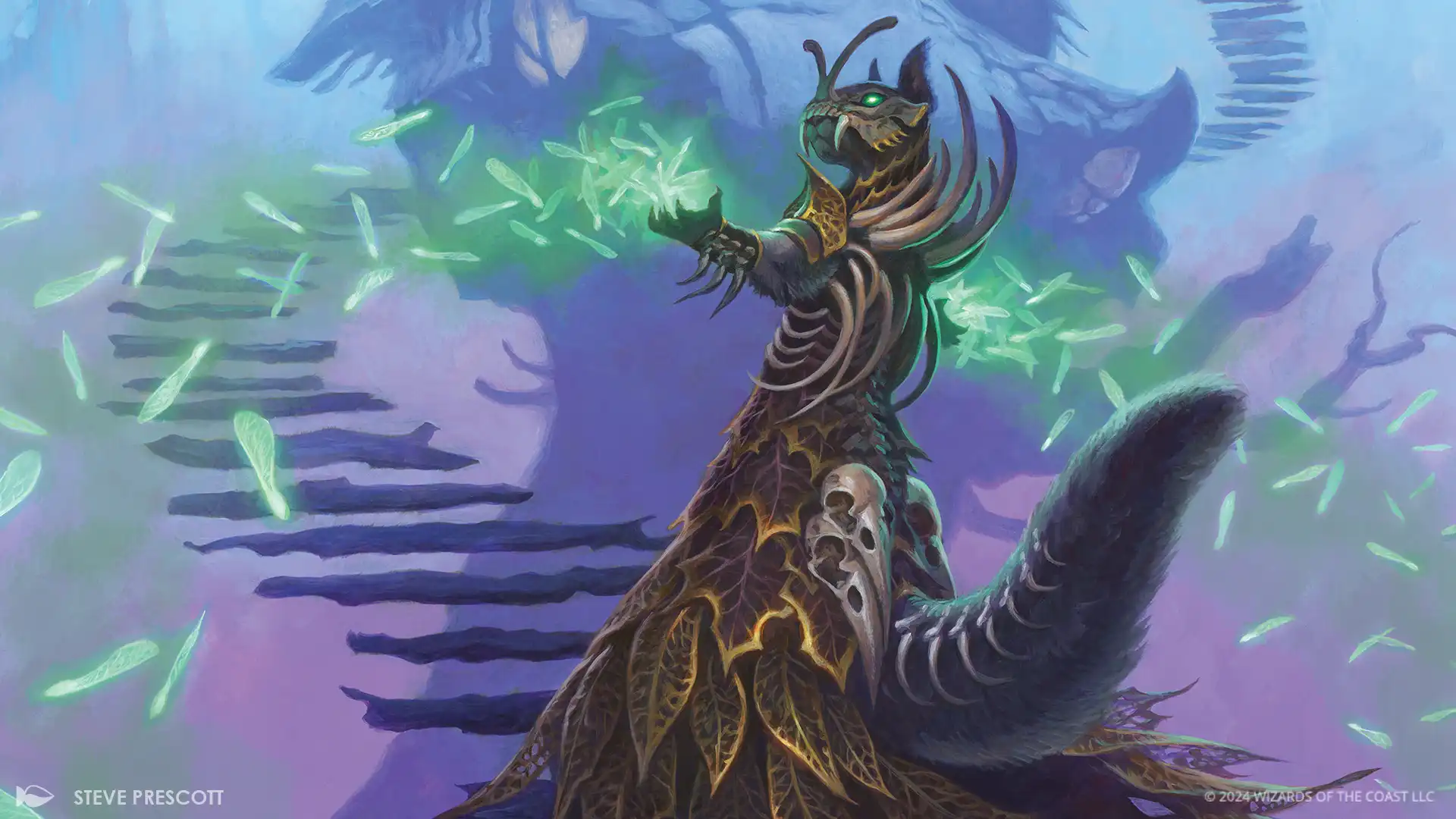
Squirrelfolk are the haughty and morbid stewards of Valley’s land and earth. Solitary, and not particularly social, squirrelfolk work with others only when necessary. Their protection and nurturing of Valley’s land takes many forms, from burying Calamity Beast remains to raising detritovores and rejuvenating farmed soils. They are pragmatic, keeping robust stores of food in case the worst should come to pass. At their best squirrelfolk are practical and conscientious stewards of the land. At their worst squirrelfolk are standoffish, rude, and dismissive.
Personalities
Squirrelfolk can come off as death-obsessed and morbid due to their role in burying Calamity Beasts, idiosyncratic sense of fashion, and magical habits. Squirrelfolk prefer the companionship of nature. It’s common for them to spend more time interacting with the land around them than with other animalfolk. Their general solitary nature also means they are chiefly concerned with their own individual survival and preservation rather than that of a wider community, and they prefer not to rely on others for their own needs.
Squirrelfolk are stewards and cultivators of Valley who consider death a vital part of the cycles of Valley, as all things that live will die. They often look down on other animalfolk for being wasteful of precious resources or ignoring the intricacies of Valley’s natural cycles, and frequently judge other animalfolk’s fear or dislike of death.
Caches
Squirrelfolk consider it their responsibility to the other animalfolk of Valley to preserve food for the harsh and sudden seasonal changes brought on by Calamity Beasts. They keep stashes of foods traded with other animalfolk, often preserving them by pickling, drying, or salting. Common foods include salted fish, pickled vegetables, dried fruits, jams, winter squashes, nuts, and seeds. Squirrels will sometimes even store their food next to the bones of Calamity Beasts, hoping to imbue the food with the power of these terrible forces of nature.
Calamitous Necromancy
Squirrelfolk believe that the Calamity Beasts have trapped the energy that should flow through nature, and as such this energy should be returned from whence it came. This is done through collecting and ritually burying remains of the Calamity Beasts throughout Valley. A small number of squirrelfolk practice a more direct form of necromancy, with the ability to wield the power of Calamity Beast remains to manipulate and animate the bones. This power is a carefully guarded secret, taught to only a select few.
Their Role in Valley
Squirrelfolk interact with the larger community of Valley infrequently and are more likely to form individual relationships with other animalfolk than larger communities. The macabre focus on death among squirrelfolk has a tendency to spawn wildly circulating rumors that leads to many animalfolk giving squirrelfolk a wide berth. Youngling mice have been known to dare each other to knock on a squirrelfolk's front door, before quickly running away. But many animalfolk rely on the squirrelfolk’s food reserves, which are vital to crop storage and the overall health of Valley.
In addition to magic that calls on the power of the land, squirrelfolk possess stealthy martial skills that let them excel as silent, unseen attackers. They are respected as formidable combatants and valued members of adventuring parties and patrols—when they can be convinced to join. Squirrelfolk are most likely to join adventuring parties if there’s a chance that they can gather and bring back the remains of Calamity Beasts.
Relationships
Squirrelfolk have particularly close relationships with other farmers in Valley, such as the rabbitfolk, trading their skills in nurturing the soil for an abundance of foods. Their mutual focus on food production, albeit at different ends of the process, creates a mutually beneficial relationship that the squirrelfolk are happy to maintain. Many squirrelfolk have a dislike of birdfolk, viewing their heroism as hollow showmanship and their desire to help others as dangerously naïve.
Weaving
Squirrelfolk have the power to raise the dead and control bones. Practicing this magic on other animalfolk is taboo, but insects and Calamity Beasts are common targets. For those squirrelfolk who are less inclined to necromancy, their magic can still turn the land and bend it to their will.
SquirellFolk Structures and Settlements
Squirrelfolk homes are large and isolated structures scattered through the thickets and swamps on stilts or decaying trees. Many squirrelfolk villages are built around Calamity Beast bones that serve as the base for thin branches to wrap around.
Mousefolk 

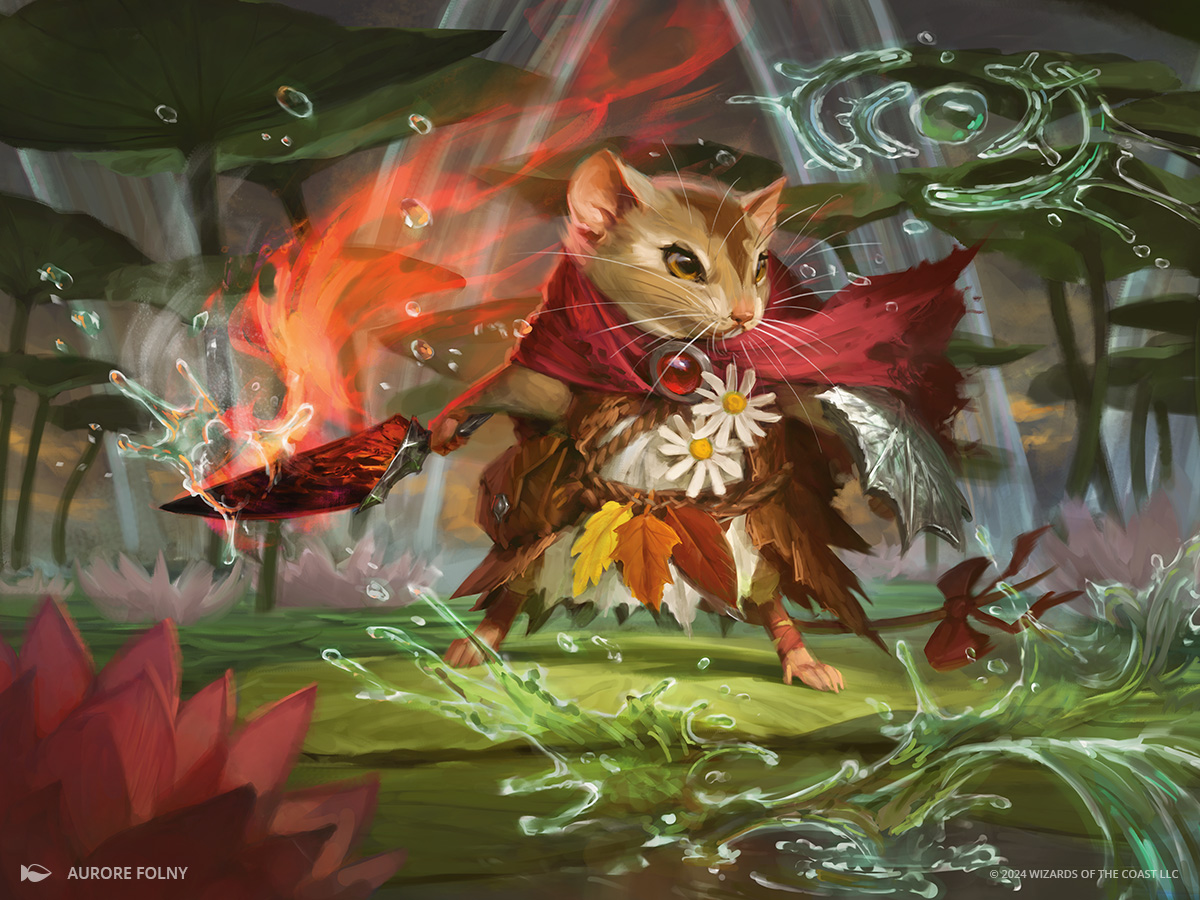
The mousefolk of Valley are plucky, eager, and goodhearted, at times to the point of naivete. They are known for their heroic actions and are often found as part of adventure parties, in search of glory and treasure. Mousefolk carry a deep sense of familial pride that drives them to strive for not just personal but also familial honor. They do not shy away from danger and frequently leap into action without hesitation, believing acts of heroism to be worth any danger. At their best, mousefolk are brave and loyal go-getters. At their worst, mousefolk are naïve and irresponsible.
Personalities
Mousefolk are action-oriented doers rather than thinkers. They prefer to seek out action and adventure. Mousefolk tend not to extensively plan, and their impulsiveness means they have a knack for finding themselves in dangerous situations. Most, however, are determined and optimistic, and will find a way to victory in even the direst situations.
Their eagerness to help others frequently drives them to fight for the protection of Valley, through both joining adventuring parties and leading the martial defenses of Valley. As sociable creatures and well-trained fighters, mousefolk are often found in leadership roles.
Deeply invested in the wider animalfolk community, they rarely hesitate to throw themselves into the service of others. Many mousefolk are drawn to glory and thrill, as they seek to emulate their venerated past champions and prove themselves as heroes. This might consist of fending off Calamity Beast attacks or finding an old otter’s favorite clam. The act of heroism is far more important than any reward.
Little Heroes
Heroism is the greatest of mousefolk virtues. Many might at first underestimate a mousefolk’s skill and power, but their small sizes disguise an immense determination, work ethic, and fighting skill that quickly earns the respect of even their deepest skeptics. Mousefolk have many trials that they can undergo, from venturing to the top of the Cliff of Heroes to the bottom of the dangerous Root Maze in search of a Calamity Beast’s lair. Each trial strengthens their body and mind in order to prove their mettle among their peers. Mousefolk study magical spells that help enhance their speed and strength so they can take advantage of their stature and dart around unsuspecting foes.
Big Numbers
The foundation of mousefolk community is their large families, which are typically led by the eldest members and involve multiple generations in a single home. With their large and interconnected families, mousefolk have lots of aunts, uncles, and cousins, and they tend to know or at least be familiar with most other mousefolk. Mousefolk community decisions are made by a gathering of family elders, who are also the main representatives of mousefolk among the rest of Valley. Mousefolk communities are collaborative, using their larger numbers to overcome collective problems that would be beyond the abilities of any one individual.
Their Role in Valley
Mousefolk are frequently found as part of adventure parties, working on large community projects, or taking up defense of Valley. Quick-thinking but impulsive, mousefolk are helpful in a crisis but often not the first choice for longer-term project planning. While they are very focused on communal good, some tend to put their bravery and heroism ahead of their own wellbeing, taking on monumental challenges alone in the belief that if they just try hard enough, they can save everyone. Mousefolk take great pride in their ability to help the larger Valley community and eagerly jump at any chance to foray out into The Brambles for resources or scarce materials.
Relationships
They can struggle to get along with the otterfolk; though similarly adventurous, mousefolk often look down on otters' games as frivolous and wasteful of time and energy that could be better spent helping others. In contrast, mousefolk tend to look to the frogfolk with great respect, valuing their thoughtfulness and seasonal predictions.
Weaving
Mousefolk are expert at using spells to augment their speed and strength. When they use their weaving, they move to fast that they appear blurred. Some mousefolk move so fast that they appear as stuttering afterimages, giving the impression that there are many mousefolk attacking their enemy.
Mousefolk Structures and Settlements
Mousefolk homes are multilevel structures made of woven grasses and leaves. Designed for multiple families, the interiors are small and cozy with a nest-like feeling. Inside you’ll find fluffy beds made from pampas grass and round windows to look out in every direction.
Frogfolk 

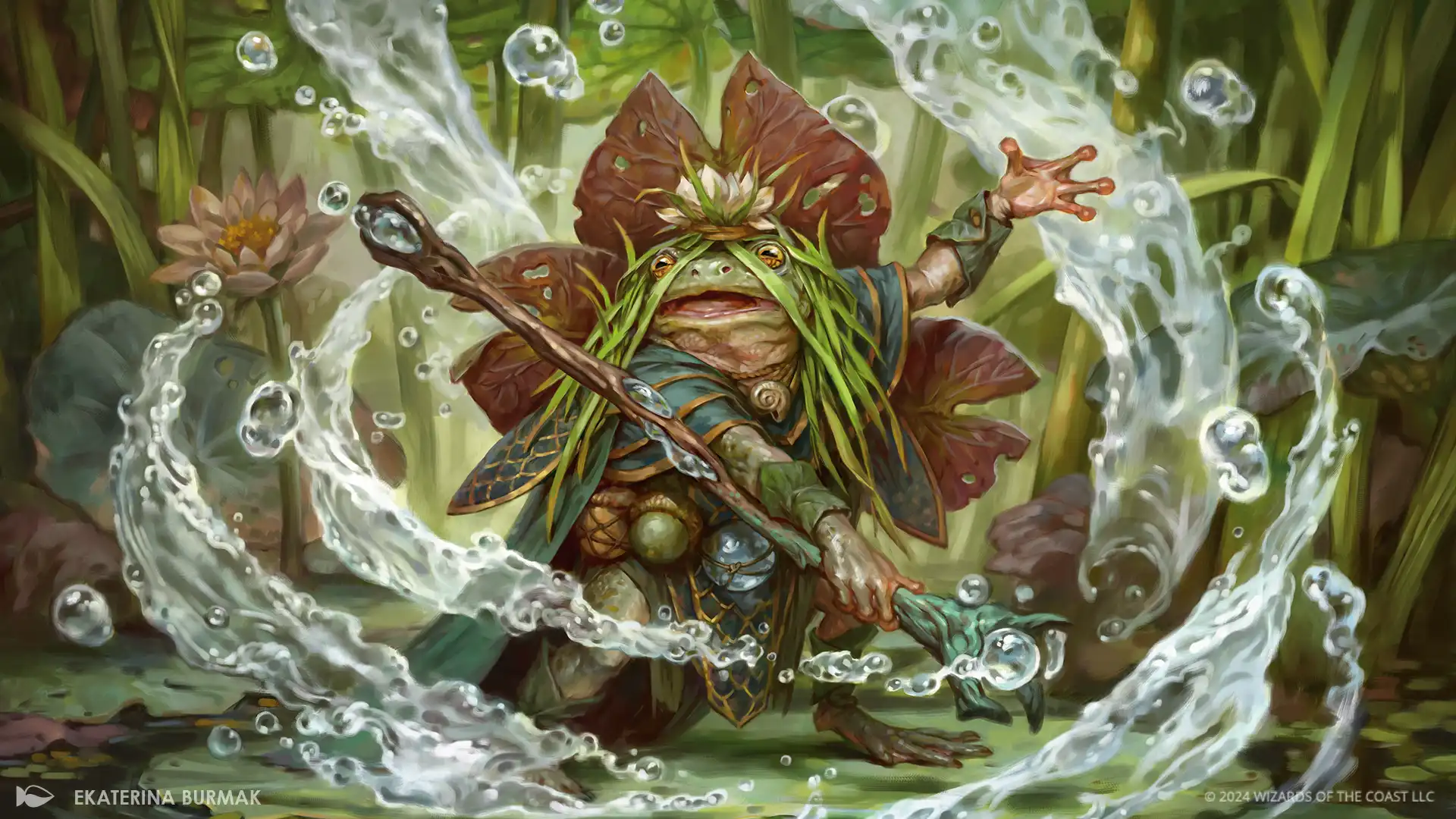
Frogfolk are augurs who use their knowledge of nature to divine the movement of Calamity Beasts and the shifting seasons in Valley. Because of their skill in preventing disaster, they are highly respected by the animalfolk of Valley, though this same quality also makes them prone to pessimism and dire proclamations of doom. Frogfolk are highly knowledgeable elementalists, their curiosity driving them to learn and discover more about the natural world throughout their life. At their best frogfolk are thoughtful and knowledgeable. At their worst frogfolk are fatalistic and disinclined to collaborate with others.
Personalities
Frogfolk have a pessimistic and fatalistic outlook on life. Even those who are not augurs still internalize the frequent predictions of Valley’s doom and feel haunted by the possibility of a terrible future they cannot escape. Their bleak outlook often means they see other animalfolk as naïve and foolish, valuing instead a pragmatic and practical approach to the world rather than an idealistic one.
It’s common for frogfolk to have a tendency towards the dramatic, exaggerating tales of their inevitable doom or jumping to the worst possible scenario even when the outcome is unclear. When they feel danger is imminent, frogfolk are serious and diligent, ensuring they have the resources to survive.
Agroforestry and Foraging
Frogfolk maintain a uniquely symbiotic relationship with the land they live on, preferring to slowly shape the direction of plant growth and maintain a complex ecosystem rather than utilize traditional farming methods. Frogfolk don’t plant crops, but rather change the environment around them to encourage certain flora to grow. They may carve out terraced shelves into a hill and flood them to grow cranberries or rice, or build a roof to protect fragile plants from withering under the sun.
Augury and Calamity
Frogfolk’s unique augury helps manipulate Calamity Beasts and mitigate potential destruction. Their skills are honed through developing a strong, intuitive understanding of the needs and balance of the natural world and by analysis of prior Calamity paths to anticipate upcoming migration patterns. The knowledge is enhanced by magical spells that help them predict the future with differing levels of specificity. At a basic level, frogfolk augurs can see the general shape of the future but cannot anticipate changes. Adept augurs can see exact movements seconds or even minutes in advance. Frogfolk augurs will plan to move entire villages, dam rivers, to send adventurers out to draw a Calamity Beast’s attention in order to prevent large-scale damage.
Their Role in Valley
Frogfolk play a key role at the start of an adventure or battle. Adventuring parties may speak with a frogfolk augur before embarking on a journey, or mousefolk knights may consult on predictions before a battle with a Calamity Beast. The most talented diviners use their skills to predict the actions of the Calamity Beasts and the resulting changes in seasons, which is invaluable to the daily life and survival of all in Valley. Many frogfolk consult on questions related to agriculture and ecology of the region. For instance, they may be conferred with regarding causes of sick crops or the impact of building in a particular location.
Despite their general reserved nature, frogfolk do not shy away from leadership positions, firmly confident in their skills and knowledge. They will sometimes take control of larger community projects, whether they were asked to or not.
Relationships
Frogfolk deeply respect racoonfolk, who share a similar admiration for nature and the world around them. Frogfolk often disapprove of the mousefolk, frustrated by their pervasive optimism, which they consider dangerous and naïve, and struggle to understand a mousefolk’s desire to hurl themselves into danger with little regard for their own safety.
Weaving
Frogfolk magic revolves around the use of water, something they always carry at their sides in some way or another. Flinging droplets or causing a wave of water are common spells. Many frogfolk can also use their water magic and augury magic to project their own limbs into the future, making portals that surprise enemies with a flurry of blows from far away.
Frogfolk Structures and Settlements
Frogfolk have round homes that are clustered together on the edges of the water. Clusters of homes form the larger community units, with buildings designed more for specific purposes than for specific families.
Other Animalfolk
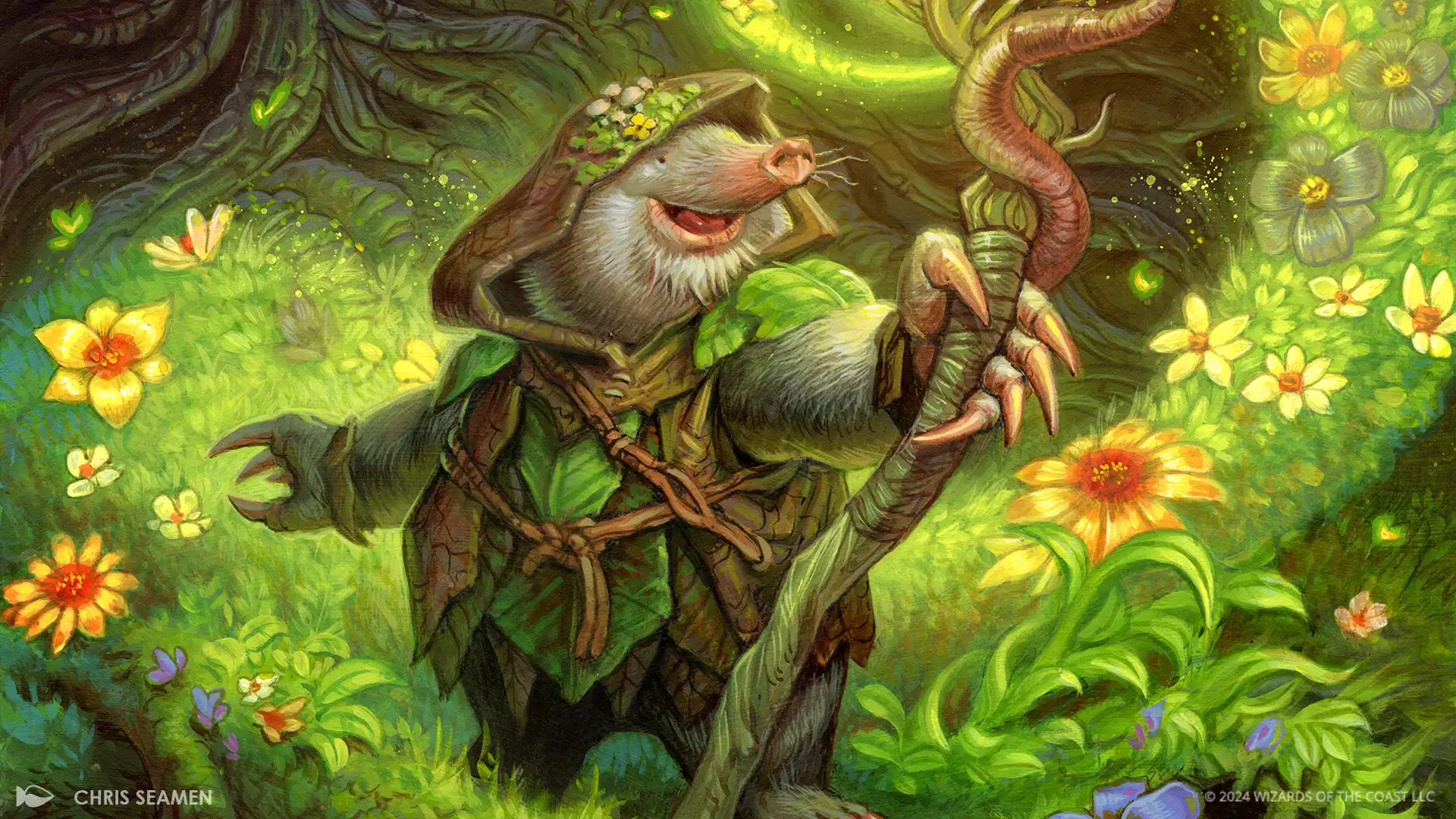
Valley is populated by multiple other animalfolk species, such as weaselfolk, molefolk, foxfolk, and more. The other animalfolk of Valley are ready to welcome them into their homes and forge new alliances. Though they are small in number, they are many in friends.
Visitors from Other Planes
Bloomburrow is bound by a powerful plane-wide enchantment. When creatures from another plane visit Bloomburrow, they are always physically transformed into a creature that is native to the plane. The visitors and denizens assume that this phenomenon is inherent to the plane itself, but whether it it a natural magical enchantment, an artifact of lingering power, mighty spell, a Calamity Beast of plane altering power, or the aftermath of some divine condition, no one yet has yet been able to discover the truth.
Preorder Now
Bloomburrow arrives August 2, and you can preorder products now through your local game store, online retailers like Amazon, and where Magic: The Gathering products are sold.


